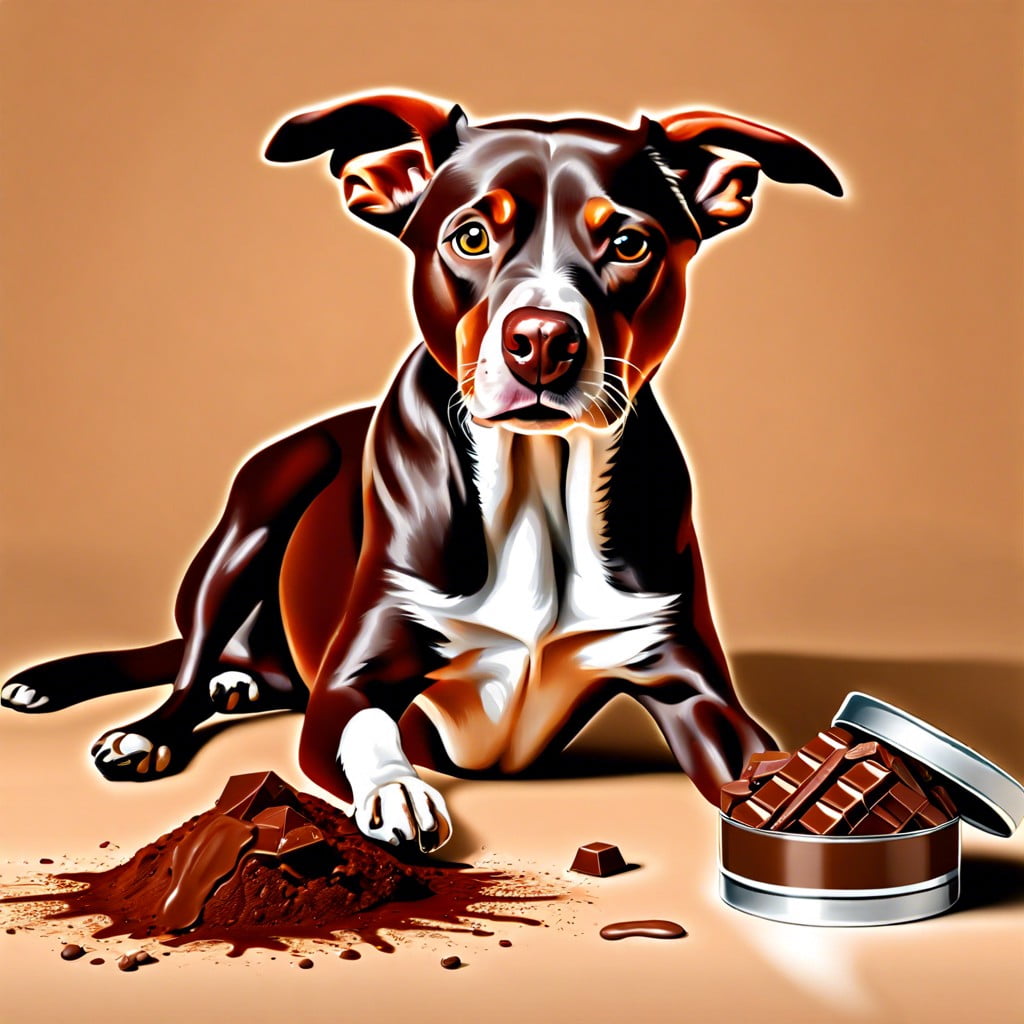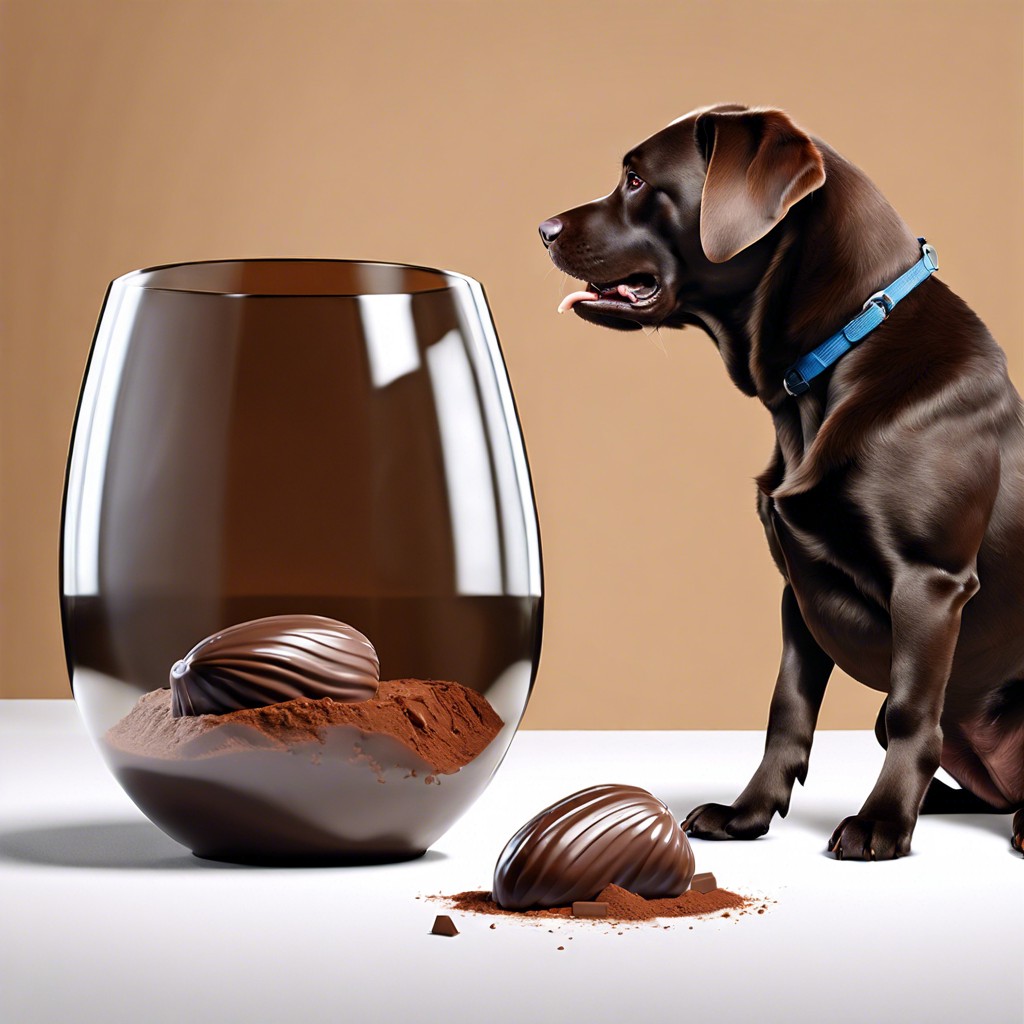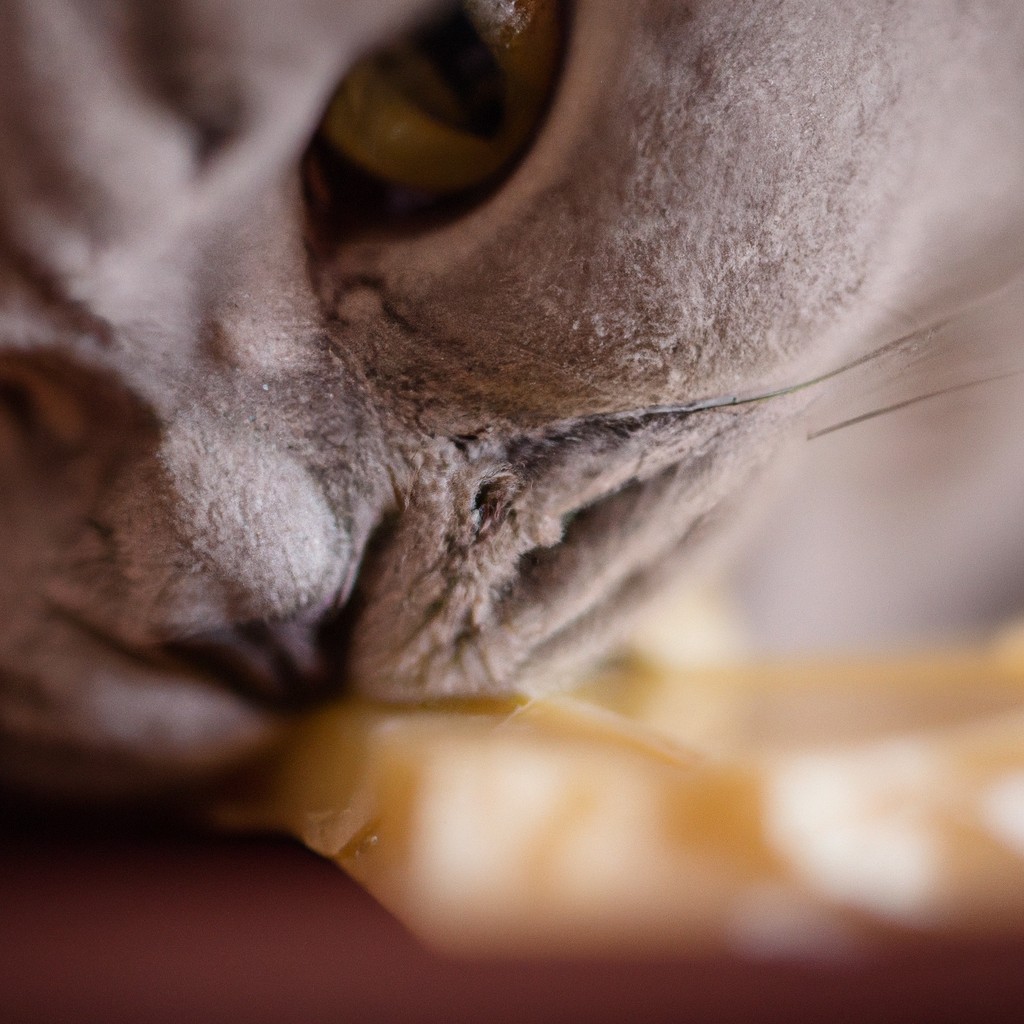This article provides a comprehensive explanation why chocolate consumption can be harmful to dogs.
Key takeaways:
- Dogs metabolize theobromine in chocolate much more slowly than humans.
- Vomiting, diarrhea, increased heart rate, restlessness, and muscle tremors are common symptoms of chocolate toxicity in dogs.
- Toxicity level depends on the type and amount of chocolate consumed.
- If a dog ingests chocolate, contact a veterinarian immediately and do not induce vomiting without professional guidance.
- Treatment for chocolate toxicity includes inducing vomiting, administering activated charcoal, IV fluids, and medications.
Inside
Chocolate and Canine Health

While humans can easily metabolize theobromine, a compound found in chocolate, dogs process it much more slowly, allowing it to build up to toxic levels in their systems. Depending on the type of chocolate, the quantity ingested, and the size of the dog, ingestion can lead to a range of health issues such as:
- 1. Vomiting and diarrhea: These are immediate and clear signs that a dog’s body is reacting negatively to chocolate ingestion.
- 2. Increased heart rate: Theobromine can cause a dog’s heart rate to spike, which may lead to more severe cardiovascular problems.
- 3. Restlessness: Affected dogs often show signs of nervousness or agitation due to the stimulant properties of theobromine.
- 4. Muscle tremors: In more serious cases, the ingestion of chocolate can cause muscle spasms or seizures.
- 5. Potential kidney failure: In the most severe instances, chocolate toxicity can lead to acute kidney injury due to theobromine’s effects on the renal system.
Understanding the risks associated with chocolate and canine health is crucial for all dog owners to ensure their pets remain safe and healthy.
The Toxicity of Theobromine in Chocolate
Theobromine, a stimulant found in cacao plants, is the primary culprit responsible for chocolate’s harmful effects on dogs. Unlike humans, dogs metabolize theobromine much more slowly, allowing it to build up to toxic levels in their system.
Key points to understand about theobromine toxicity in dogs include:
- Theobromine affects the central nervous system and cardiac muscle, leading to potential hyperactivity, seizures, and irregular heartbeats.
- The level of toxicity depends on the type and amount of chocolate consumed and the size of the dog. Dark chocolate contains much higher levels of theobromine than milk or white chocolate.
- Even small amounts of chocolate can cause adverse reactions. Symptoms typically appear within 6 to 12 hours after ingestion and can last up to 72 hours.
- Early symptoms often include vomiting, diarrhea, restlessness, and increased urination. More severe symptoms might manifest as cardiac issues, muscle tremors, or seizures.
Knowing the dangers of theobromine is essential for all dog owners to ensure the health and safety of their pets.
Immediate Actions If a Dog Eats Chocolate
If a dog ingests chocolate, acting promptly is imperative. Remove any remaining chocolate to prevent further consumption. Assess the quantity and type of chocolate eaten and note the time of ingestion; this information is crucial for veterinarians.
Contact a veterinarian immediately or call an animal poison control hotline. They can provide guidance based on the specifics of the situation. Do not attempt home remedies like inducing vomiting unless instructed by a professional, as this may cause additional harm to the dog.
Prepare for a possible emergency visit to the vet, bringing the chocolate wrapper along to assist the vet in understanding the potential theobromine content the dog has been exposed to. Keeping calm is essential, as dogs can pick up on owner distress, which may aggravate their anxiety and symptoms.
Treatments for Chocolate Toxicity in Dogs
If your dog has ingested chocolate, time is of the essence, and a veterinarian should be consulted immediately. Treatment typically includes:
- Inducing Vomiting: To prevent further absorption of theobromine, a vet may induce vomiting if the chocolate was ingested very recently.
- Administration of Activated Charcoal: This helps to absorb the toxins present in the chocolate, preventing further absorption into the bloodstream.
- IV Fluids: Intravenous fluids are often administered to help stabilize the dog, support kidney function, and expedite the excretion of theobromine.
- Medications: Depending on symptoms, medications may be needed to manage heart rate, blood pressure, or seizures.
Monitoring and supportive care will continue until the theobromine has been adequately metabolized and the dog’s vital signs are stable. Always follow your vet’s specific instructions and recommendations for the best outcome.
Preventive Measures to Avoid Chocolate Ingestion By Dogs
To ensure your pet’s safety, it is essential to store all chocolate products out of their reach. Place chocolate in closed, high cabinets, just as you would with any hazardous substance.
Educate all family members, especially children, about the dangers chocolate poses to dogs. Encourage them to vigilantly keep their treats to themselves.
During holidays like Easter or Halloween, when chocolate is more prevalent, be extra cautious. Check your children’s accessible stash, and after events, scan your home and yard for any stray chocolate that might tempt a curious dog.
Consider using dog-safe chocolate alternatives for treat-making that contain carob, which mimics chocolate’s flavor without the toxicity.
When baking or cooking with chocolate, keep your dog out of the kitchen to prevent them from snatching any spills or scraps.
If you suspect someone might give your dog chocolate, such as well-meaning visitors, be proactive. Inform them of the risks beforehand and provide dog-safe snacks for them to offer instead.
Always supervise your dog when they’re in an environment where chocolate could be within paw’s reach. If you’re unable to watch them closely, it’s safer to keep them in a secure, chocolate-free zone.
By adopting these simple habits, you can help create a safe environment that allows your dog to thrive without the threat of chocolate poisoning.




